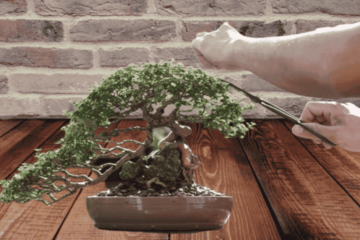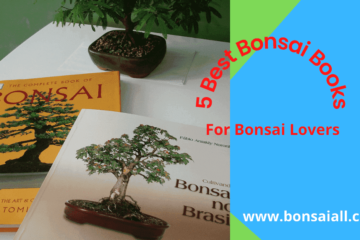The art of growing a perfect bonsai tree is fascinating and can be as precise and special as the tree itself. When it comes to bonsai care, there are many factors you need to consider, but do bonsai trees need sunlight?
Each individual species of bonsai tree has different light requirements, but they generally require direct sunlight to thrive. It is recommended that the average bonsai receives 5-6 hours of light per day, although some trees will have different needs. Artificial light can be used as an alternative if sunlight is limited.
If you are worried about where to place your bonsai and how to give them the right amount of light, this article is here to help. You’ll find out everything you need to know about bonsai and the light levels they need to thrive.
Do bonsai trees need sunlight to survive?
Content Overview
So, do bonsai trees need sunlight to survive? The answer is yes – and usually a lot. Most bonsai trees are actually species that grow best outdoors, where they can receive the maximum amount of sunlight throughout the day.
Although bonsai trees are so miniature, they are fundamentally the same plants as fully grown trees of the same species. They take in nutrients, watering and gain energy in the same way as other plants. All plants use ultraviolet light in a process called photosynthesis, which produces sugars that give trees the energy to survive.
If a tree, or any other plant for that matter, cannot photosynthesize, it will not be able to generate enough energy to survive and grow. Without enough sunlight, a bonsai tree will begin to wither, lose its leaves, and eventually bonsai tree dying.
Basically, a bonsai tree cannot survive without getting enough sunlight. Fortunately, artificial light can do the same job that sunlight traditionally does, so if the sun isn’t shining, there are other ways to meet your bonsai’s “sunlight” needs.
Are bonsai trees winter hardy?
If your bonsai species is native to your environment or an environment with a similar climate, your bonsai tree may be winter hardy for you. This makes caring for your bonsai significantly easier as you don’t have to worry about moving your bonsai to a new location when the temperature drops.
Some species may need to be moved to a sheltered location if there is strong wind in your area as this can dry out some bonsai very quickly. Very strong sunlight can have the same effect in winter. Bonsai may not be able to take up enough water quickly if the roots freeze.
More mature bonsai trees can usually tolerate winter a little better than younger bonsai trees. But it is important to know the species of your bonsai. If you have tropical or even semi-tropical species, a slight cold or frost can cause damage. Monitor the temperature to determine when to move your bonsai indoors if necessary.
In addition to being dependent on the bonsai species, winter hardiness also depends on your climate. A species winter hardy in Florida is unlikely to be winter hardy in Maine.
Where to keep bonsai trees indoors?
The general recommendation is to keep bonsai trees outdoors as much as possible. However, when bonsai plants will experience temperatures outside of the range they are in in their natural environment, you will need to provide additional protection and possibly bring your bonsai trees indoors.
How much sunlight your bonsai needs indoors also depends on the plant species. Generally you’ll want to provide as much light as possible if your bonsai is growing indoors (usually during the winter).
Here’s what to consider.
How much sunlight do plants need?
The amount of sunlight for a bonsai depends on whether it is an outdoor or indoor bonsai tree. But most bonsai plants require an average of 5 to 6 hours of direct or indirect sunlight per day.
In exceptional cases such as after extensive pruning or repotting, your bonsai plant will need proper sunlight every day.
Outdoor bonsai trees need to be exposed to all the changing seasons to survive. They need 5 to 6 hours of direct sunlight per day.
Some outdoor bonsai trees may even need more or less direct sunlight. For example, juniper bonsai trees need direct sunlight to grow.
Again, Pomegranate and Japanese Maple bonsai trees, although outdoor bonsai trees, prefer partial sunlight to direct sunlight.
Temperate bonsai plants are usually outdoor plants. This is because they have a dormancy period that is triggered by temperature and seasonal changes. In summer they soak up sunlight and in winter they are dormant.
Tropical bonsai plants are indoor plants. So they don’t like direct sunlight. But they should provide indirect sunlight.
If bonsai plants are kept on a windowsill or shaded porch, they may need up to 16 hours of sunlight. So, the position and way you position your bonsai tree is very important for proper lighting.
Can bonsai trees live in low light?

The list of bonsai plants that grow well in low light is not very long. Some bonsai tolerate several months of low light during the winter, especially if the plant species slows down or goes dormancy during the winter.
If you are looking for bonsai that will grow in low light all year round, you have a few options; But even with these options, you’ll still want to make sure they have some access to natural light while indoors. The best bonsai trees for low light are the rubber tree, lucky bamboo, northern island pine, Madagascar dragon tree, and Hawaiian umbrella tree.
Note that with the exception of the North Island Pine, there is some debate as to whether the other species above can really be made into bonsai because they do not respond to shaping and pruning like other bonsai trees.
However, they all make beautiful miniature specimens of plants that can survive indoors. The label or classification of bonsai is a matter of debate because these species can produce specimens that look like bonsai.
Will bonsai trees grow in the shade?
Tree species grown as bonsai require as much sunlight or shade as their full-sized forms. Although some plant species prefer outdoor shade, indoor shade provides significantly less light exposure than outdoor shade.
If you can afford a shaded spot indoors, consider using grow lights to give your bonsai plants some access to light. Plants need sunlight for photosynthesis, so bonsai need at least some level of sunlight to grow properly.
Where to place my bonsai tree to get sunlight?
Choosing the right spot for your bonsai tree may seem like a decorative task, but your first consideration should actually be the amount of light your plant gets. The three main concerns that matter when you’re looking at locations for your bonsai are how many hours of light it will receive, where that light is falling, and whether it’s direct or indirect.
Not all bonsai species like the same amount of sunlight, but bright spots are generally better. In general, a sunny windowsill will provide your plant with the most light and encourage the healthiest growth. In the Northern Hemisphere, south-facing windows receive the most sunlight throughout the day and north-facing windows receive the least sunlight.
Most common bonsai tree species are actually outdoor plants, so they are unlikely to grow indoors. Junipers, conifers, spruces, yews, azaleas, cypress trees and many others are happiest when they are outdoors and receive a good amount of bright sunlight. Not every outdoor bonsai is the same though, and some may prefer a bit of dappled shade in the afternoon.
How do I know if my bonsai is getting enough light?
Even if you’re aware of how much sunlight your bonsai plants want throughout the day, it’s hard to tell if they’re actually getting it or not. Instead of trying to count the hours of daylight and keep track of the weather, you can look at your plants’ signs that tell you if they’re getting the right amount of light.
If your bonsai is colorful, tasty, vibrant, and growing well, it’s probably getting the sunlight it needs. Your bonsai tree may not be getting enough light, however, if:
It is starting to wilt
If your bonsai tree doesn’t get enough sunlight, it will likely start to weaken and wither. A wilting bonsai is usually either under water or lacks the energy it needs to get from sunlight.
Its leaves are less vibrant
The green color on the inside of bonsai leaves comes from the chlorophyll it uses for photosynthesis. The more sunlight a plant receives, the more chlorophyll it will produce and therefore the greener its leaves will be. Dull leaves that lack color can be a sign that your plant isn’t getting enough light.
It is leaf fall
You may notice that your bonsai is shedding more leaves than usual and this could be due to lack of sunlight, especially if it is an evergreen species or it is the wrong time of year. Bonsai plants drop leaves to conserve moisture and energy if they are not productive, which often happens when they are not exposed to enough light.
Your plant may even show you where they drop more leaves on one side than the other where there is a lack of light.
Brittle Foliage
Some bonsai trees may not shed their leaves immediately; They can be dry and brittle instead. This is another sign that your plant is pulling moisture away from those leaves because they are not able to get enough energy through them.
It’s not growing
Although bonsai trees are supposed to be small, they should still grow at a healthy rate. Bonsai growth should be controlled by pruning and maintenance, as they are not struggling to survive. Lack of growth often means your plant needs more light, and this can eventually be fatal.
No matter how small a tree is, it must grow and change to survive.
Pests and diseases
Your bonsai is more susceptible to pests and diseases like spider mites,aphids, Malybugs when it is weakened by lack of light. An unhealthy tree cannot recover from damage the way a healthy one can.
Make sure your indoor bonsai receives enough natural light or artificial light to keep it healthy. If your bonsai is suffering from pests or disease, treat the problem, but make sure you give your bonsai enough light to make it easier to recover.
Can you grow a bonsai tree with artificial light?
Knowing how important sunlight is for a bonsai tree to grow healthily, it may seem impossible for them to survive without it. Fortunately, there are many ways to replicate the sun’s life-giving energy through artificial light.
If you want to grow a bonsai with only artificial light, or need to supplement the amount of natural light you’re getting, there are a few things you need to consider.
Photosynthetically Active Radiation is Important
Photosynthetically active radiation, or PAR, is a term you’ll often hear when you’re looking at artificial lighting for plants. This basically refers to the amount of light your plant can use for photosynthesis, and some light sources will have a higher PAR than others.
Choose the right type of artificial light
There are three main types of artificial lighting that you can use to grow your bonsai: fluorescent lights, HID lights, and LED lights. Each has its own pros and cons, so you’ll want to choose the right option for your needs.
Position and power your artificial lights carefully
A major advantage of artificial lighting is that you can choose exactly where the light hits your plants and for how long. This means that you need to be very aware of exactly how much light your plants need and what kind of light you are giving them.
Some artificial lights have to be very close to the plants and left on for many hours to replicate the energy of sunlight.
Fluorescent lights are low output
Fluorescent lights are generally very inexpensive to purchase and more readily available than other forms of artificial lighting. They also have quite a low output in terms of PAR, so they need to be very close to the foliage and left on for 16-18 hours a day if they are to be used as a primary light source.
If your bonsai tree turns yellow, here are the reasons.
HID Lights Penetrate Deeply
HID lights, or high-intensity discharge lights, produce an intense, bright light that penetrates deep into the leaves. They are strong enough for outdoor use and don’t need to last very long, but they cost a lot to run, are difficult to adjust and run very hot. These lights usually require frequent replacement and can burn your bonsai if you’re not careful.
LED lights are energy-efficient and long-lasting
LED lights can be expensive to purchase, but they are incredibly energy-efficient and last much longer than any other form of artificial lighting. They produce a full spectrum of light but produce very little heat, so overuse of them is unlikely to harm your plants. LED is generally considered the healthiest artificial light for most bonsai plants.
Also Read :The Ultimate Guides How To Revive a Bonsai tree
Recap: Do bonsai trees need sunlight?
So, do bonsai trees need sunlight? Well, the answer is probably a bit more complicated. Ultimately, all plants need sunlight to grow and survive, but some plant species need less light than others – and artificial lighting can work when sunlight isn’t available.
Your bonsai will need light for photosynthesis and energy gain. Natural sunlight is the best source for this, and most bonsai plants thrive in bright light conditions. However, some plants have different needs and you can use artificial light as an alternative.
At the end of the day, the exact needs of your bonsai will come down to the type of plant you have, but light is one thing that no plant can live without.


